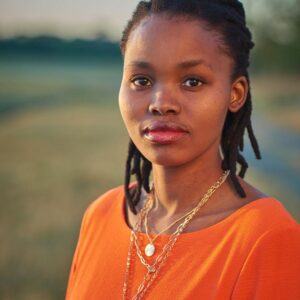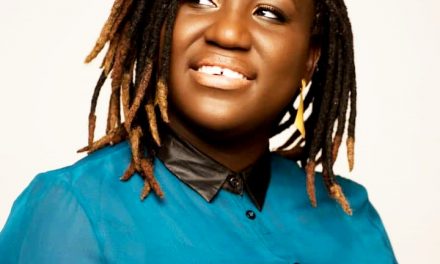We can’t address women taking up space without referencing Atang Sharon. She literally cleared the delta’s bush to found The Space Botswana , a newly established art gallery and creative hub based in Maun, Botswana. We caught up with Atang to learn more about her journey.
Can you explain what it means to be a multimedia artist? What’s the back story behind discovering your artistry?
Multimedia means being able to use different types of media and creativity to produce variations of art. I knew I was an artist when the numbers did not make sense to me, LOL… Honestly speaking, it was in high school when all I wanted to do was paint and bunk, other classes. My art teacher motivated me to stay true to myself and in my own lane. During my final IGCSE’s, I did a lot of research on my art project. I enjoyed the process and felt, ‘this is me, this is my purpose’. If I could help other people to discover how great they are by sharing space and creating, then I would be content.


Of all the mediums you have worked with, do you have a favorite? What is your artistic process? Your sources of inspiration? Do you have artists you aspire to?
My favorite has to be oil paints. The colors are consistent and don’t dry up quickly, that way I have time to work on something else while I wait. Multitasking seems to be the most sensible thing to do when you have an infant and a toddler. My artistic process is very much random, I paint when I need to not when I have to. I mostly use my emotions and that plays a huge role in what to expect. Travel and everyday life are my sources of inspiration. The challenges and the wins of being in existence. My loving husband is also a great influence. His work ethic, the way his mind works, and the quality work he produces always inspire me.
What has been your experience with being an Artist within the Southern African and Botswana landscape?
It has been difficult. The fact that Art Education especially in Botswana is lacking means I must keep pushing myself for my dreams at all costs (mentally, physically, and emotionally) to prove that art is valid, valuable, crucial, and seriously therapeutic. It’s a battlefield! It is going to take some time, but I see some African Artists doing well out of their art. The difference is Africa has become such a trend in Western culture that sometimes it’s hard to tell if the work is great or it is just the popularity of being a black artist.
What have been some of the milestone moments of your career thus far? Do you have a favorite artwork?
Building the art gallery and traveling to make conservation impact documentaries in Rwanda, Angola, and Namibia. My favorite piece thus far must be the one I did in Namibia titled ‘Reflections”.

Sharon Atang pictured with ‘Reflections’ art work and art works from The Space Botswana
How did you come up with the idea for The Space Botswana? And why base it in Maun?
I was tired of looking for places to hang my artwork and collaborate with like-minded people. I was looking for opportunities but wasn’t really finding them in Botswana, this led me to create ‘The Space’ that I would like to work in as an artist. There are few private Art Galleries in Botswana and Maun is just different. A small Safari Town with a lot of interesting people and landscapes. It’s the landscape that I connected much with. Nature and art blend well. I am actively creating a space for network, organizational, and business development within the cultural and creative industries sector. The hope is to open more hubs nationally and internationally.

The Space Botswana
How do you bridge the gap between showcasing and embracing local artistry whilst reaching for an international market? How do you still include the everyday Motswana within your business approach?
I go looking for artists in remote villages as they are the most under-represented people. You find that their talent is the best because it is organic. It takes very little mentoring, investment, and practice to hone their skills to industry standards. I currently have five artists that I sponsor with art material and space to produce art. In our case, the geo-centric location of being in The Okavango Delta and Moremi Game Reserve means we are dependent on tourists, but the Covid-19 pandemic has meant we also have to educate the local market on the consumption of art.
What do you dislike about the art world?
It is very tricky to navigate. The prestigious schools and high-level networks make it unfair for artists who have no educational background to represent themselves in a professional manner. However, The Space Botswana Art gallery is the change I’ve been wanting to see because above all we represent artists who produce high-quality work with an in-depth understanding of the subject matter.
How has the transition from artist to manager been for you?
It has been interesting, I had to re-educate myself on the business of art and managing basics, doing entrepreneurial courses, and understanding social impact. I learn and watch what goes on in the Art world, especially how African artists are pushing boundaries and narratives.
The making of The space Botswana

What are you doing to encourage women to take up space in the industry?
I am mentoring some female artists and would love to have more. Hopefully, we can have an annual ‘strictly women’ exhibition for The Space Botswana eventually.
Now that you’ve achieved your dream of being a gallerist, what’s next for you?
I want to grow the gallery and have local artists showcase their works internationally. I would also like to support residencies for international collaboration. Eventually, I would love to go back to acting, but I am still raising the kids so that can wait until I have the time.

Atang describes herself first as a mother of two to a boy and girl, a wife and thereafter, a gallerist, artist, and creative soul. She holds a Creative Multimedia degree and runs her own Multimedia Production company- Lipstick and Dust (Pty) Ltd. She has exhibited her paintings at Thapong Visual Arts 2014 (TAYA), Maun International Arts Festival (M.I.A.F) and Okavango Arts Association (OAA) members exhibition from 2016 to date. She was a regional winner during the 2018 Presidents Day Competition in the Photography section. She has been involved in Photography workshops as a Technical Assistant for the Botswana Society of the Arts and Botswana Deaf Association in collaboration with the European Union as well as with Kalahari Images for M.I.A.F Photography Workshops.





